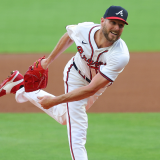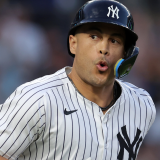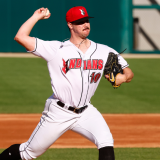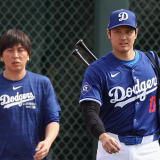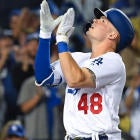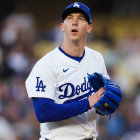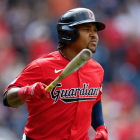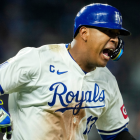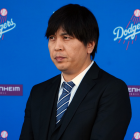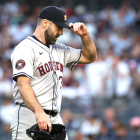With the regular season concluding, we've decided to take a look at each team's future -- not by using a crystal ball or other psychic abilities, but by evaluating their farm systems. Below you'll find our ranking of the top five prospects in the organization -- sorted by perceived future potential -- as well as five other players who fit various categories. Those categories are:
2020 contributor: A player who is likely to play a role for the big-league team next season.
Analyst's pick: A player who is a strong statistical performer and/or whose underlying measures are better than the scouting reports suggest.
Riser: A player on the way up.
Faller: A player on the way down.
One to watch: An interesting player to keep in mind (for whatever reason).
These rankings were compiled after talking with various industry sources about the systems (and players) in question. It should be acknowledged that this process is more art than science, and that there are limits to ordinal rankings. Still, it's an intuitive system, and our hope is that the write-ups will answer any questions by providing additional context and analysis of each player -- such as their pluses and minuses; the risk factors involved; and their estimated arrival date.
One last word on eligibility: we're following MLB's rookie guidelines by disqualifying any player with more than 130 big-league at-bats or 50 innings pitched.
As if the Dodgers didn't already have enough things working in their favor, they have a number of players about to graduate or make their big-league debuts.
1. Gavin Lux, MIF
By now, everyone is probably familiar with Gavin Lux, who appeared in 23 games with the Dodgers down the stretch.
For the exceptions in the crowd, Lux spent most of the season terrorizing minor-league pitching. He hit .347/.421/.607 with 26 home runs across Double- and Triple-A. He did that while playing the entire season as a 21-year-old who primarily played shortstop.
In other words, Lux is a well-rounded player -- one who can hit for average and power, walk, and so on. The main question with him at this point is where he'll play on the big-league team. The Dodgers used him exclusively at second base during his big-league cameo, and it's probably fair to slot him in there for as long as Corey Seager is hearty and hale.
2. Dustin May, RHP
Dustin May also debuted this season for the Dodgers. In 14 appearances he threw 34 innings, fanned 32 batters and walked five and accumulated a 115 ERA+.
May has a quirky aesthetic thanks to a high leg kick, but it's been fair to project him as a mid-rotation starter thanks to his athleticism and a high-grade fastball-curveball combination.
May has added a cutter in recent seasons, and that pitch has become his main secondary offering as he's seemingly lost the feel for the curve (he used it only 10 percent of the time during his big-league stay). It's at least possible that the cutter is directly responsible for it -- you'll often hear pitchers warn about throwing too many, since it leads to them getting around the ball rather than behind it -- but we can't say for sure.
If May can get the curve back, he'd have three above average or better pitches at his disposal. That, combined with his control, could position him as a No. 2 starter.
3. Keibert Ruiz, C
Young catchers are nearly as prone to attrition as young pitchers, but Keibert Ruiz is an intriguing prospect worth keeping an eye on.
Ruiz split the season between Double- and Triple-A, where he compiled eight more walks than strikeouts. He fanned just once in 40 Triple-A plate appearances. Remember, he did that as a 21-year-old switch-hitting backstop.
Ruiz's age and obvious bat-to-ball skills make it easier to forgive some of his sins -- his free-swinging ways; his so-so production this season; his lack of power output. It's at least possible he puts it all together and becomes a high-grade hitter. Of course, it's also possible he has to maintain a high average to buoy an otherwise unremarkable line.
Projection is tough.
The good news for Ruiz is that he is considered an above-average defender whose framing should grant him a wide berth. There's a chance he's an All-Star, there's a better chance he's not. Either way, he has a skill set that doesn't come around often behind the plate.
4. Tony Gonsolin, RHP
Tony Gonsolin was yet another member of this list who already debuted in the majors.
Gonsolin made 11 appearances (six starts) for Los Angeles, beginning in June, and posted some quality marks: 40 innings, 37 strikeouts, 15 walks, a 143 ERA+, and so on. Over his final 36 frames, he permitted just 20 hits and held opponents to a .535 OPS.
Gonsolin is a well-built right-hander who is already nearing his 26th birthday. He showed four pitches during his time in the Show: a low-to-mid 90s fastball with good spin, a splitter, a slider, and a curveball. All of the secondaries recorded whiff rates over 30 percent (albeit in a smallish sample), speaking to the depth of his arsenal.
Gonsolin should be in the Dodgers' Opening Day rotation, health provided, and could be a mid-rotation starter for years to come.
5. Josiah Gray, RHP
The Dodgers acquired Josiah Gray (among others) as part of the Yasiel Puig, Alex Wood trade with the Cincinnati Reds last offseason.
Gray, Cincy's second-round pick in 2018, is a smallish right-hander with a drop-and-drive delivery and a lively arm. Both his fastball and his slider have a chance to play above-average, and he's thrown a ton of strikes throughout his professional career. So far, Gray hasn't walked so many as three batters per nine in any given season.
Gray does need to continue to refine his changeup. He'll turn 22 in December, so there's time for him to do so and avoid a career in relief.
2020 contributor: Jeter Downs, SS
Jeter Downs, also acquired in the Puig trade, hit .276/.362/.526 with 24 home runs and 24 stolen bases (on 32 tries) across High- and Double-A. Not bad for a 20-year-old. Downs remains a shortstop for now, but the expectation is that he'll end up moving to second base, or perhaps even the outfield. His bat should play wherever he lands -- and he figures to debut late in the season.
Analyst's pick: DJ Peters, OF
DJ Peters is a fascinating prospect: a 6-foot-6, 225-pounder with big-time raw power and enough arm and speed to convince the Dodgers to play him mostly in center field. The catch is that he's prone to striking out. A lot. He's fanned at least 30 percent of the time in every season since he reached A-ball, and that doesn't seem likely to change -- not now, perhaps never. Peters hit .260/.388/.490 in 57 Triple-A games and will require protection from the Rule 5 draft this winter, suggesting his big-league debut will occur within a year.
Riser: Miguel Vargas, 3B
Teenage infielder Miguel Vargas split the season between Single- and High-A, hitting .308/.380/.440 with seven home runs. Vargas is already listed at 6-foot-3, 205 pounds and could end up having to move away from third base -- perhaps even across the diamond to first. Such a shift down the defensive spectrum would require him to better leverage his strength. He's young and clearly can hit a lick, so there's reason for hope.
Faller: Jeren Kendall, OF
Perhaps it's unfair to name Jeren Kendall since the shine came off the former first-round pick last season. But he did technically improve upon his performance his second go-around in High-A, which may inspire hope that he's on the right track. Let it be noted that he struck out in nearly 36 percent of his plate appearances, suggesting the odds remain stacked against him becoming a capable big-league player.
One to watch: Gerardo Carrillo, RHP
There were a number of compelling candidates for this spot. In the end, Gerardo Carrillo won out despite some blah statistics due to his live arm. Though he spent this season as a 20-year-old, he's bumped the upper-90s with his fastball in spurts and has posted impressive spin rates on his breaking stuff. Carrillo is likely to conjure Marcus Stroman comparisons due to his size and willingness to alter his delivery to disrupt timing. As is often the case with pitchers of this size, he's also likely to encounter concerns about his durability. Carrillo may end up in the bullpen, he may end up a mid-rotation starter, but he's certain to be someone the Dodgers get asked about in most every negotiation from here on out.









